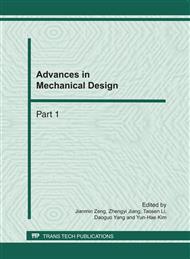[1]
Mario M. Foglia, Angelo Gentile, Giulio Reina. Robotics for Agricultural Systems. Springer Berlin Heidelberg: Mechatronics and Machine Vision in Practice. (2008). pp.313-332.
DOI: 10.1007/978-3-540-74027-8_27
Google Scholar
[2]
E.J. Van Henten, J. Hemming, B.A.J. Van Tuijl, J.G. Kornet, J. Meuleman, J. Bontsema and E.A. Van Os. An Autonomous Robot for Harvesting Cucumbers in Greenhouses. Autonomous Robots vol 13, (2002), p.241–258.
DOI: 10.1023/a:1020568125418
Google Scholar
[3]
Edan T., Rogozin D., Flash T., and Miles G. E. Robotic Melon Harvesting. IEEE Trans. on Robotics and Automation, Vol. 16 (6) , (2000), p.831–834.
DOI: 10.1109/70.897793
Google Scholar
[4]
Gieling, Th.H., Van Henten, E.J., Van Os, E.A., Sakaue, O., and Hendrix, A.T.M. Conditions, demands and technology for automatic harvesting of fruit vegetables. Acta Horticulturae, vol 440, (1996), p.360–365.
DOI: 10.17660/actahortic.1996.440.63
Google Scholar
[5]
Grand, d'E., Rabatel, A. G., Pellenc, R., Journeau, A., & Aldon, M. J. Magali: A self-propelled robot to pick apples. American Society of Agricultural Engineering Paper, vol 46, (1987), p.360–365.
Google Scholar
[6]
Hayashi, S. and Sakaue, O. Tomato harvesting by robotic system. ASAEAnnual International Meeting, Phoenix, Arizona, USA Paper 963067. (1996).
Google Scholar
[7]
Kondo, N., Monta, M., and Fujiura, T. Fruit harvesting robots in Japan. Advances in Space Research, vol 18(1/2), (1996). p.181–184.
DOI: 10.1016/0273-1177(95)00806-p
Google Scholar
[8]
Ling, P., Ehsani, R., Ting, K., Yu-Tseh Chi, Ramalingam, N., Klingman, M., Draper, C. Sensing and End- Effector for a Robotic Tomato Harvester. ASAE Paper no. 04-3088. St. Joseph, Mich.: ASAE. (2004).
DOI: 10.13031/2013.16727
Google Scholar
[9]
Monta, M., Kondo, N., and Ting, K.C. End-effector for Tomato Harvesting Robot. Artificial Intelligence Review. Vol 12, (1998), p.11–25.
DOI: 10.1007/978-94-011-5048-4_1
Google Scholar
[10]
Sakai, S., Osuka, K., Iida, M., and Umeda, M. Control of a heavy material handling agricultural manipulator using robust gain-scheduling and μ-synthesis. Proceedings IEEE International Conference on Robotics and Automation, (2003), p.1967–(1970).
DOI: 10.1109/robot.2003.1241579
Google Scholar
[11]
Tian-Hu Liu, Xiang-Rong Zeng and Zhi-Hong Ke. Design and Prototyping a Harvester for Litchi Picking. (2010).
Google Scholar


